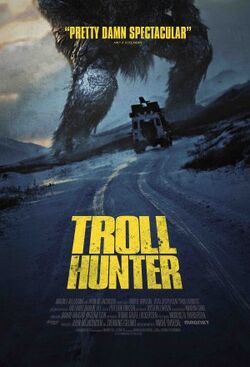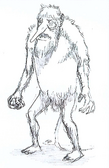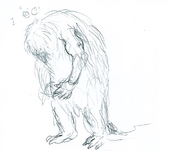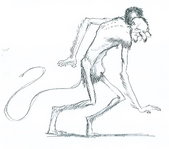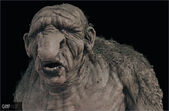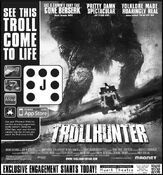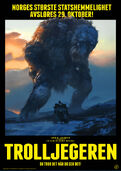| TROLLHUNTER | |
|---|---|
| Directed by | André Øvredal |
| Produced by | John M. Jacobsen
Sveinung Golimo |
| Written by | André Øvredal |
| Starring | Otto Jespersen
Hans Morten Hansen Tomas Alf Larsen Johanna Mørck Knut Nærum Robert Stoltenberg Glenn Erland Tosterud |
| Cinematography | Hallvard Bræin |
| Editing by | Per-Erik Eriksen |
| Studio | Filmkameratene A/S
Film Fund FUZZ |
| Distributed by | SF Norge A/S
(Norway) Magnet Releasing (United States) |
| Release date(s) | *October 29, 2010 |
| Running time | 103 minutes |
| Country | Norway |
| Language | Norwegian |
| Budget | NOK 19 million
($3.5 million) |
| Box office | NOK 24 million
($4,159,678)[1] |
Trollhunter (Norwegian: Trolljegeren; Swedish: Trolljägaren; UK: Troll Hunter; US: Trollhunter; Canada: The Troll Hunter) is a 2010 Norwegian dark fantasy film, made in the form of a "found footage" mockumentary. It is written and directed by André Øvredal, and features a mixed cast of relatively unknown actors and well-known Norwegian comedians, including Otto Jespersen. Trollhunter received positive reviews from Norwegian critics. It opened on June 10, 2011 in the U.S,[2] to a mostly positive critical reception.[3]
Plot[]
A group of university college students, Thomas (Glenn Erland Tosterud), Johanna (Johanna Mørck), and their cameraman Kalle (Tomas Alf Larsen) set out to make a documentary about a suspected bear poacher, Hans (Otto Jespersen). At the site of an illegally slain bear, they interview local hunters, who comment that the bear tracks look odd, as well as Finn Haugen (Hans Morten Hansen), head of the Norwegian Wildlife Board. Finn dismisses the idea that the bear tracks could have been faked. Like true paparazzi, the students follow Hans, who tells them to go away. As they follow him into a forest, they see mysterious flashing lights and hear roars. Hans comes running back screaming "Troll!" Thomas is attacked and bitten by a large animal. They escape in Hans’ Land Rover, and discover their own vehicle, a green first-generation VW Golf, turned over with the tires mysteriously missing. Hans admits that he does not hunt bears, but trolls. Though skeptical, the students ask if they can join Hans and film his hunt. Hans consents.
The next day Hans makes them disguise themselves with troll 'scent', and checks if any of them believe in God or Jesus, because a troll can smell a Christian man's blood. Hans wields a “flash gun,” a weapon that emits powerful UV-rays to simulate sunlight and turn trolls to stone, though he comments that sometimes the trolls “just explode.” The students are stunned when Hans flushes out a giant three-headed troll. As Hans destroys the troll, Finn of the Troll Security Service arrives with a team to deposit a bear carcass. Finn then plants fake tracks. Finn angrily tells the students that they will not be allowed to keep their tapes.
In a series of interviews, Hans reveals that he works to keep trolls a secret and to kill any that come near populated areas. The trolls are acting aggressively and have begun to leave their territories more often than usual, and Hans must get a troll blood sample to try to determine why.
The students accompany Hans on another hunt using live goats on a bridge as bait. Hans takes the blood to a veterinarian who works for the TSS but finds that it will take several days before any results can be found. Investigating a farm where a number of trees have been inexplicably uprooted, Hans and the film crew find troll tracks leading into an abandoned mine, lair of a pack of trolls. The trolls return unexpectedly, and the group is trapped inside. The situation gets more tense when Kalle confesses that he is a Christian. After they quietly sit in the cave the trolls catch his Christian scent and eat him for supper, while the others manage to escape.
The replacement camerawoman is a Muslim; Hans is uncertain about how trolls will react to that. Finn demands that Hans head north to troll territory to get the problem under control. The group finds signs of a Jotnar, a giant mountain troll, 200 meters tall. Thomas falls ill, and they learn that the troll blood sample came back positive for rabies. Thomas has been infected by the bite received several days earlier.
Hans manages, after several attempts, to kill the Jotnar by launching a rocket-like projectile that transforms the troll into stone. He directs the others to find the highway. Finn and his government agents arrive to confiscate the students’ tapes. Thomas flees with the camera and is seen collapsing at the side of a road when the tape cuts out. Just before the cut to a black a truck is seen stopping next to the camera. Presumably, the driver is the person who "found the footage". An epilogue tells the audience that none of the students were heard from again. The film ends with a genuine edited[4] news clip of the Norwegian Prime minister Jens Stoltenberg inadvertently admitting to the existence of trolls, though the press fails to take notice.
Cast[]
- Otto Jespersen as Hans
- Hans Morten Hansen as Finn Haugen
- Tomas Alf Larsen as Kalle
- Johanna Mørck as Johanna
- Knut Nærum as Power company manager
- Robert Stoltenberg as Polish bear hunter
- Glenn Erland Tosterud as Thomas
- Urmila Berg-Domaas as Malika Malay-Olsen
Production[]
Filming took place in the forests and mountains of Western Norway, and actress Johanna Mørck called it an exhausting experience.[5] According to director André Øvredal, the team tried to maintain maximum secrecy around the project. They kept both the title and cast secret until shortly before the première; instead dropping cryptic teasers to create a viral effect.[6]
Producers John M. Jacobsen and Sveinung Golimo reported great international attention around the film. Already before the première, several American companies had expressed interest in doing a remake.[7] Jacobsen and Golimo's production company were also responsible for the highly successful 2008 film Max Manus.[7]
Conceptual artworks[]
Promotion[]
Augmented reality[]
Posters[]
Reception[]
Dagbladet's Inger Merete Hobbelstad gave the film four points out of six, and compared it to The Blair Witch Project. She complained that the dramaturgy could be better at times. The special effects she found to be of variable quality, though certain scenes were "amazing". She also highlighted Jespersen's performance as essential to the film's success.[8] The film received four points out of six in the newspapers Klassekampen[9] and Verdens Gang as well. Verdens Gang critic Morten Ståle Nilsen summed it up as "Better than we feared. Weaker than we could hope." Nilsen also made the comparison to The Blair Witch Project, and though he did not find Trollhunter brilliant or original, he predicted great commercial success for the film. Like Hobbelstad he appreciated Jespersen's effort.[10]
The most favorable review from the major national newspapers was written by Mode Steinkjer in Dagsavisen, where the film received five out of six points. He commended Øvredal's ability to combine "subtle humor with physical tension", and also commented on the "striking naturalness" displayed by Tosterud, Larsen, and Mørck as the three students.[11] Kjersti Nipen, on the other hand, reviewing the film for Aftenposten, gave the movie only three points out of six. She called it "flat, predictable and rather devoid of content". Although she regarded it as funny at times, she found the use of the mockumentary format exhausted and overused.[12] The review in Morgenbladet was not favorable either.[13]
The most favorable review in Norway came from NRK, the Norwegian Broadcasting Company; Birger Vestmo gave the film six out of six points, and wrote that “a new Norwegian classic is born." He also applauded the film for combining Norwegian cultural elements with Hollywood cinematic flair.[14]
Among American reviews, Mike Hale of The New York Times called it a "clever and engaging mock documentary" with "ultradry Nordic humor", though "about 20 percent too long" with "more traveling shots through car windows of the fjord-land scenery than are absolutely necessary". The special effects, while "created with a computer-graphics budget that we can assume was far short of the Hollywood standard, are surprisingly lifelike and frightening."[15] Frank Lovece of Film Journal International praised star Jespersen for "what ought to be a star-making dramatic performance", and found the film "both a remarkably suspenseful voyage ... and a dry-witted commentary on the nature of expedient bureaucracy.... Part horror movie, part social satire, and bursting with Norway’s savage beauty ... [i]t is destined to be a classic of its kind."[2] V. A. Musetto of the New York Post gave it three stars out of four and cautioned, "You'll want to catch this clever movie before Hollywood ruins everything with a dumb remake."[16] British writer Ross Miller of Blog Critics gave it 4.5 stars out of 5 and said, "Troll Hunter takes what is now a conventional style of found footage filmmaking and puts a unique stamp on it... one of the best examples of this type of film so far."[17]
On review aggregate website Rotten Tomatoes, Trollhunter currently holds an 82% 'Fresh' rating.[3]
Soundtrack[]
The song "Mjød" by Kvelertak is featured over the ending credits, followed by "In the Hall of the Mountain King" from Norwegian composer Edvard Grieg's music for the play Peer Gynt.
Cultural references[]
Trollhunter contains many references to Norwegian culture and Norwegian folktales in particular. Among those is the belief that there are different species of trolls, for example, the woodland and mountain trolls, which as in the film can be further categorized into subspecies. The most well known is probably the Mountain King which is mentioned in the play Peer Gynt and its music by Edvard Grieg. The Norwegian name for Mountain King, «Dovregubbe», is a compound word, and the first part is the same word used in the mountain range Dovrefjell, which is also where they meet the final troll.
Other common troll descriptions from the Norwegian folklore which are used in the film include trolls having a tail, can have multiple heads, can smell a Christian's blood, usually eat rocks, but loves meat and can be man-eaters. The trolls are also described as big, old, strong, but slow and dim-witted and turns to stone upon contact with sunlight. The latter is a point emphasized in the film, as the Troll Hunter uses UV-light to kill the trolls. However, Hans also makes a statement that not everything from the tales are true.
The film also makes references to the often heated conflict between farmers and predators eating their livestock and the farmers' limited ability to react without breaking Norwegian wildlife regulations[21] Of course, in the film these predators get the blame for what the trolls are doing. Similarly, there are conflicts that arise when new power lines need to be made through the landscape.[22] The often bureaucratic Norwegian society is also referenced when the Troll Hunter shows and fills out his form.
As reflected by how the students answer the Troll Hunter, only a fraction of Norwegians consider themselves religious or visits the church regularly,[19] even though the majority of Norwegians are members of the state church.[20] In the way the final cut is made, it is ambiguous if the trolls reacted to Christian scent and songs, or just to unusual scent and noises in general. Or the psychological belief that they believed the trolls recognize it and react accordingly. The film also has several specific references to fairy tales. For example, Boots Who Ate a Match With the Troll when the cameraman asks about an eating contest and the Three Billy Goats Gruff when the Troll Hunter attempts to trap the troll under the bridge. The fairy tale Soria Moria Castle is one of the tales that tell trolls can smell a Christian man's blood. A painting by Theodor Kittelsen based on the same fairy tale is also used as a backdrop on one on the trips they do in the film. The looks of the trolls in the film is also influenced by painters like Theodor Kittelsen and John Bauer.[18]
With several of the cast being comedians that are fairly known to the Norwegian audience, including Otto Jespersen playing the Troll Hunter, it also sets the tone of the film for many. Robert Stoltenberg playing the Polish bear hunter makes that scene less serious and plays on facts and stereotypes that most Norwegian immigrants are from Poland,[23] often speak mediocre Norwegian or English, do what they are told without asking questions[24] and often do the work Norwegians won't do themselves.[25]
Another minor detail is the inclusion of svele when the Hans is eating on the ferry.
Remake[]
Main article: Trollhunter (remake)
The day the film opened in the United States, Deadline.com announced that director Chris Columbus's company, 1492, along with CJ Entertainment & Media had acquired remake rights to the film.[26]
In a 2016 interview, director Andre Overdal confirmed that the remake had been canceled, and that the rights Troll Hunter franchise currently lies with Overdal.
Sequel[]
Main article: Troll Hunter 2
Awards and nominations[]
| Year | Association | Category | Nominated work | Result |
|---|---|---|---|---|
| 2011 | Amanda Award[27] | Best Visual Effects (Årets visuelle effekter) | Oystein Larsen & Marcus B. Brodersen | Won |
| Public Choice Award | André Øvredal | Won | ||
| Best Actor (Årets mannlige skuespiller) | Otto Jespersen | Nominated | ||
| Best Editing (Årets klipp) | Per-Erik Eriksen | Nominated | ||
| Best Screenplay (Årets filmmanuskript) | André Øvredal | Nominated | ||
| Brussels International Fantastic Film Festival | Silver Raven Award for Best Director | Nominated | ||
| Newport Beach Film Festival[28] | Outstanding Achievement in Filmmaking | Won | ||
| 2012 | 17th Empire Awards[29] | Best Horror | Trollhunter | Nominated |
| 38th Saturn Awards[30] | Best International Film | Nominated | ||
| Fangoria Chainsaw Awards | Best Foreign-Language Film | Nominated |
References[]
- ^ Trollhunter at Box Office Mojo
- ^ a b Lovece, Frank (10 June 2011). "Film Review:Trollhunter". Film Journal International. Retrieved 10 June 2011.
- ^ a b Trollhunter at Rotten Tomatoes
- ^ [Chris] (6 May 2011). "Interview: Andre Ovredal, Director of ‘TrollHunter’!!" (in English). BloodyDisgusting.com. Retrieved 12 May 2012. "he’s actually talking about…a huge oil field outside of Norway that’s called the Troll Field. And he was talking about power supplies/t."
- ^ Ødegård, Espen (29 October 2010). "– Som et eventyr å være med på". Ringerikes Blad (in Norwegian). Retrieved 29 October 2010.
- ^ Hole, Ronald; Lars Holger Ursin (26 October 2010). "– Det var helt vilt". Bergens Tidende (in Norwegian). Retrieved 29 October 2010.
- ^ a b Haugen, Ida Anna (28 October 2010). "Film: «Trolljegeren»-produsent: – Man må ta troll på alvor".Verdens Gang (in Norwegian). Retrieved 29 October 2010.
- ^ Hobbelstad, Inger Merete (28 October 2010). "Tøys og tull—og troll". Dagbladet (in Norwegian). Retrieved 29 October 2010.
- ^ Kulås, Guri (28 October 2010). "Troll i ord?".Klassekampen (in Norwegian). p. 28.
- ^ Nilsen, Morten Ståle (27 October 2010)."Trolljegeren". Verdens Gang (in Norwegian). Retrieved 29 October 2010.
- ^ Steinkjer, Mode (28 October 2010). "Sprekker ikke".Dagsavisen (in Norwegian). Retrieved 29 October 2010.
- ^ Nipen, Kjersti (28 October 2010). "Trolljegeren".Aftenposten (in Norwegian). Retrieved 29 October 2010.
- ^ Eriksen, Ulrik (29 October 2010). "Sprekkeferdig".Morgenbladet (in Norwegian). pp. 28–29.
- ^ Vestmo, Birger (26 October 2010). "Trolljegeren".NRK (in Norwegian). Retrieved 26 October 2010.
- ^ Hale, Mike (9 June 2011). "Movie Review Trollhunter(2010)". The New York Times. Retrieved 10 June 2011.
- ^ Musetto, V. A. (9 June 2011). "Just grin and bear the trolls". New York Post. Retrieved 10 June 2011.
- ^ Miller, Ross (19 June 2011). "EIFF 2011 Movie Review: Trollhunter". Blog Critics. Retrieved 19 August 2011.
- ^ "Know Your Trolls: A guide to troll science from the director of TrollHunter". io9. 5 May 2011.
- ^ "Få nordmenn i kirken, men ikke færre enn før" (in Norwegian). 20 June 2011.
- ^ "More participants at communion". Statistisk Sentralbyrå. 20 June 2011.
- ^ "Norsk Sau og Geit er skeptisk til rovdyrtapstall for sau". Nationen (in Norwegian). 27 October 2011.
- ^ "Kampen fortsetter i Hardanger". NRK (in Norwegian). 26 June 2011.
- ^ "Immigrants and Norwegian-born to immigrant parents". Statistisk Sentralbyrå. 28 April 2011.
- ^ "– Norskundervisning er ikke nok for å unngå arbeidsulykker" [Language classes are not enough to avoid work accidents]. NRK (in Norwegian). 6 December 2011.
- ^ "- Det eksisterer ikke polakkarbeid, bare arbeid" [- There is no such thing as Polish work, only work]. E24(in Norwegian). 8 December 2011.
- ^ Fleming, Mike (10 June 2011). "Norwegian Fright Film 'Trollhunter' In Remake Deal With Chris Columbus' 1492 And CJ Entertainment". Deadline.com. Retrieved 10 June 2011.
- ^ "Amanda Winners 2011". filmweb.no. August 27, 2011. Retrieved July 3, 2012.
- ^ Peters, Sarah (May 6, 2011). "Newport Beach Film Festival announces awards". Daily Pilot. p. 2. Retrieved 3 July 2012.
- ^ Reynolds, Simon (March 25, 2012). "Jameson Empire Awards 2012 - winners in full". Digital Spy. Retrieved July 3, 2012.
- ^ "The 38th Satrun Awards Nominations".saturnawards.org. Retrieved July 3, 2012.
Other sources[]
Rees, Ellen 'Trolls, Monster Masts and National Neurosis: André Øvrelid’s The Troll Hunter.' Scandinavica 50.2 (2011): 52-62
External links[]
- Official website
- Troll Hunter - Official UK Hubsite
- Official YouTube Channel
- Official Norwegian Facebook Page
- Official UK Facebook Page
- Official US Facebook Page
- Trollhunter at the Internet Movie Database
- Trollhunter at Rotten Tomatoes
- Trollhunter at Box Office Mojo
- Trolljegeren at Filmweb.no (Norwegian)
- Radish, Christina. "André Øvredal Exclusive Interview: Troll Hunter", Collider.com, May 2, 2011. WebCitation archive.
